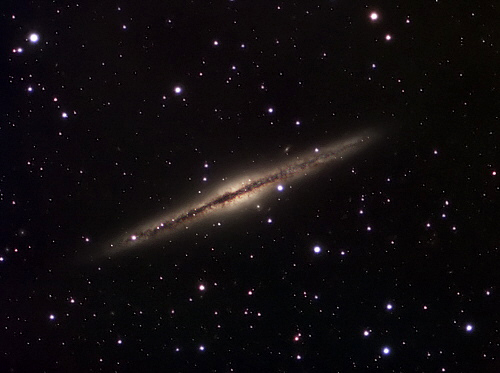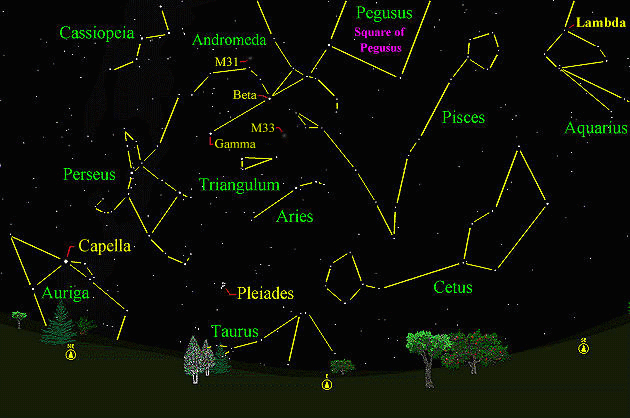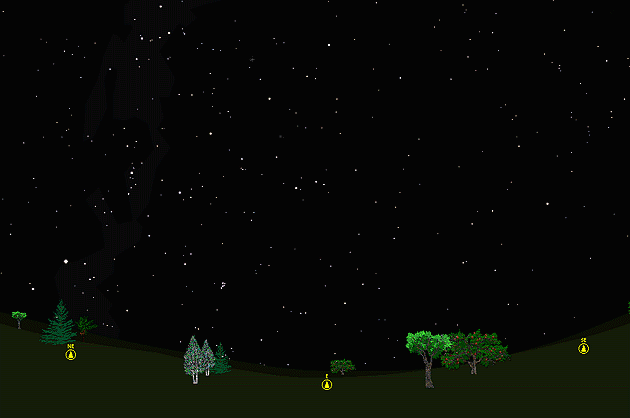The purpose of this feature is to give scout leaders, educators and naturalists an idea of some of the natural events coming up each month. We will try to cover a variety of natural events ranging from sky events to calling periods of amphibians, bird and mammal watching tips, prominent wildflowers and anything else that comes to mind. We will also note prominent constellations appearing over the eastern horizon at mid-evening each month for our area for those who would like to learn the constellations. If you have suggestions for other types of natural information you would like to see added to this calendar, let us know! Note: You can click on the hyperlinks to learn more about some of the featured items. To return to the Calendar, hit the "back" button on your browser, NOT the "back" button on the web page. All charts are available in a "printer friendly" mode, with black stars on a white background. Left clicking on each chart will take you to a printable black and white image.
Notes and Images From September 2008 Ghost: There is something about the galaxy NGC 891 that gives it a mysterious quality. Discovered by William Herschel in 1784, this perfectly edge-on galaxy is about 30,000,000 light-years away. Located in the constellation Andromeda, its position is easy to find, but its low surface brightness can make it devilishly hard to see in a small telescope. September 23rd brought the first really clear night for a while, and I spent some time imaging the galaxy. It was a pleasantly cool night, and an Eastern Screech-Owl called from the tree line along our driveway. I began imaging the galaxy about 11:30pm and continued till around 2:30am, stopping every now and then to adjust the driving mechanism on the telescope. As the photons pattered down around me and the hours went by, the fall constellations rotated overhead. It was as if I was fast-forwarding through the season. By the time I was finished, Capella and Aldebaran were high above the eastern horizon, and the winter constellation of Orion was rising in the southeast. The temperature kept getting cooler, and although the crickets soldiered on in their songs, the Katy-dids slowed to an occasional raspy "did--did" -----"did--did". As I wrapped things up and walked back toward the house, a Great Horned Owl called from the fields across the railroad tracks. It is the first of our Tennessee birds to breed, and it will be on the nest in January. In its voice is the promise of a new season of birth and growth, even as the old season is coming to a close.
In September it seems like the wildflowers put on one last burst of color. Morning Glories climb the fences beside the road and Jerusalem Artichokes blaze from the edges of the fields. Jerusalem Artichoke is a rather strange-sounding name for a native wildflower. It is a member of the Sunflower family, genus Helianthus, and was named an artichoke because its tubers are edible and nutritious. But why Jerusalem? The answer has nothing to do with the city of Jerusalem. For this flower, the word Jerusalem is a corruption of the Italian word "girasole," which literally means "turns toward the sun." Although not all sunflowers exhibit this behavior, Jerusalem Artichokes do seem to turn toward the sun. When you see a patch of these flowers note how the whole assemblage faces the sun and changes orientation throughout the day.
Sky Events for October 2008: The Orionid Meteor Shower peaks in the morning hours of October 21st, but a last quarter Moon will tend to hamper observations a bit. Evening Sky: Jupiter shines brightly in the southern sky at dusk in Sagittarius. As the month progresses, bright Venus climbs higher and higher into the sky at dusk above the western horizon. A thin waxing crescent Moon shines below Venus on October 31st, and the two should make a pretty pair. Morning Sky: Mercury has its best morning apparition of the year in October, reaching greatest elongation from the sun on October 22nd. Watch low in the eastern sky for the fleet-footed planet from around October 17th through the end of the month. A good time to observe it is about 30 minutes before sunrise. Saturn rises about 2 hours before sunrise in Leo at the beginning of the month. During October the tilt of Saturn's rings decreases from 3.6 degrees to 2.1 degrees. All times noted in the Sky Events are for Franklin, Tennessee and are Central Daylight Time. These times should be pretty close anywhere in the mid-state area.
Constellations: The views below show the sky looking east at 9:30pm CDT on October 7th. The first view shows the sky with the constellation outlined and names depicted. Star and planet names are in yellow. Constellation names are in green. The second view shows the same scene without labels. Prominent are Cassiopeia, Queen Cassiopeia, Andromeda, Princess Andromeda, Perseus, Triangulum, the Triangle, Aries, the Ram, and Cetus, the Sea Monster. Look above beta Andromedae and see if you can pick out the faint glow of the M31, The Andromeda Galaxy. City dwellers may need binoculars to pick it out. To get the best view, wait until the square is high overhead to look. If you find the Andromeda Galaxy, you might want to try to see M33, another nearby galaxy in Triangulum. If you want to try and see NGC 891 with a telescope, center gamma Andromeda in your eyepiece, turn off your clock drive if you have one, and then simply wait 18 minutes and 40 seconds. The rotation of the earth will point your telescope in the right direction. When you look again the galaxy will be in the center of the field of view. It's quite faint, and you will be doing well if you can make out the ghostly central bulge. The dark dust lane usually requires a large telescope to be seen well. Auriga, the Charioteer, with its bright star Capella, and Taurus, the Bull, are rising in the northeast. Look for the Pleiades, a beautiful open star cluster, not far above the eastern horizon. Also called the "Seven Sisters," this cluster has been known since antiquity. In Japan it is known as Subaru, and the Subaru automobile is named for this cluster.
On Learning the Constellations: We advise learning a few constellations each month, and then following them through the seasons. Once you associate a particular constellation coming over the eastern horizon at a certain time of year, you may start thinking about it like an old friend, looking forward to its arrival each season. The stars in the evening scene above, for instance, will always be in the same place relative to the horizon at the same time and date each October. Of course, the planets do move slowly through the constellations, but with practice you will learn to identify them from their appearance. In particular, learn the brightest stars for they will guide you to the fainter stars. Once you can locate the more prominent constellations, you can "branch out" to other constellations around them. It may take you a little while to get a sense of scale, to translate what you see on the computer screen or what you see on the page of a book to what you see in the sky. Look for patterns, like the stars that make up the "Square of Pegasus." The earth's rotation causes the constellations to appear to
move across the sky just as the sun and the moon appear to do. If you go
outside earlier than the time shown on the charts, the constellations will be
lower to the eastern horizon. If you observe later, they will have climbed
higher. As each season progresses, the earth's motion around the sun causes the constellations to appear a little farther towards the west each night for any given time of night. The westward motion of the constellations is equivalent to two hours per month. Recommended: Sky Publishing has just come out with a beautiful and compact star atlas, Sky & Telescope's Pocket Star Atlas. It is destined to become a classic, and is a joy to use at the telescope. A good book to learn the constellations is Patterns in the Sky, by Hewitt-White. You may also want to check out at H. A. Rey's classic, The Stars, A New Way to See Them. For skywatching tips, an inexpensive good guide is Secrets of Stargazing, by Becky Ramotowski. A good general reference book on astronomy is the Peterson
Field Guide,
A Field Guide to the Stars and Planets, by Pasachoff. The book retails for around $14.00. Starry Night has several software programs for learning the night sky. Visit the Starry Night web site at www.starrynight.com for details.
Amphibians:
The frog and toad choruses continue to diminish in October, but some frogs and toads are still calling. Listen for Spring Peepers to call from patches of woods in the fall. On cool October nights, Southern Leopard Frogs call and breed as the cooler temperatures mirror their early spring breeding period. Upland Chorus Frogs sometimes give a very dry, raspy version of their call in October. You can locate many of the frogs and toads that have been calling more frequently earlier in the year by driving the back roads slowly on rainy nights. This is a two person job. One person watches the road for amphibians and one person looks out for other vehicles.
Birds: Fall migration continues. Try to get out and bird as often as you can. Recommended: Bird Finding in Tennessee, Michael Lee Bierly. A classic guide to finding birds in Tennessee. The Sibley Guide to Birds, David Allen Sibley The Sibley Guide to Birds of Eastern North America, David Allen Sibley A Field Guide to the Birds of Eastern and Central North America, 5th edition. 2002. Roger Tory Peterson and Virginia Marie Peterson. If it's been a while since you've picked up a Peterson bird guide, you may be pleasantly surprised by the large image scale of the drawings. Just the thing for those fall warblers! An inexpensive guide for beginners is the Golden Guide for Birds.
Archives (Remember to use the back button on your browser, NOT the back button on the web page!) Natural Calendar September 2008 Natural Calendar February 2008 Natural Calendar December 2007 Natural Calendar November 2007 Natural Calendar September 2007 Natural Calendar February 2007 Natural Calendar December 2006 Natural Calendar November 2006 Natural Calendar September 2006 Natural Calendar February 2006
Natural Calendar
December 2005
Natural Calendar
November 2005
Natural Calendar
September 2005
Natural Calendar
February 2005
Natural Calendar
December 2004
Natural Calendar
November 2004
Natural Calendar
September 2004
Natural Calendar
February 2004
Natural Calendar
December 2003
Natural Calendar
November 2003
Natural Calendar
September 2003 Natural Calendar February 2003 Natural Calendar December 2002 Natural Calendar November 2002 Nature Notes Archives: Nature Notes was a page we published in 2001 and 2002 containing our observations about everything from the northern lights display of November 2001 to frog and salamander egg masses. Night scenes prepared with Starry Night Pro software All images and recordings © 2008 Leaps |




